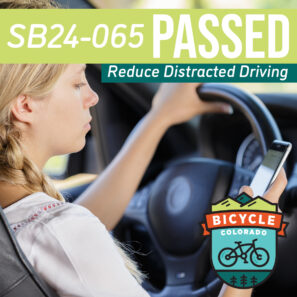The Colorado Safety Stop is the law of the land
Earlier today, on April 13, 2022, Governor Jared Polis signed the Colorado Safety Stop into law. That means bicyclists like you have a new safe and legal option to proceed through intersections across the state.
This new law means that when an intersection is clear and they already have the right of way, bicyclists ages 15 and older may now treat stop signs as yield signs and treat stop lights as stop signs.
Additional details of the law include:
- Younger bicyclists may perform the maneuver if an adult is present.
Bicyclists can yield and then proceed through stop sign-controlled intersections at up to 10 miles per hour. - Intersections where bicyclist-specific lights or signs are present that prohibit the maneuver are exempt from the new law.
- The bill defines “low speed conveyances” in Colorado law. These are small profile, low-speed vehicles that people use for transportation and recreation, including bicycles and electric bicycles, electric scooters (not including mopeds), and wheelchairs.
This has been an effort years in the making and all of us at Bicycle Colorado are immensely proud to cross the finish line on this safety-enhancing policy and call the Colorado Safety Stop the law of the land. The data is clear: this prevents crashes between bicyclists and drivers where they happen the most—intersections—and that’s why we’ve fought so hard for this to become statewide policy for so many years.
We owe a huge debt of gratitude to our bill sponsors in 2022 who championed the Colorado Safety Stop in the legislature, and especially the bill’s prime sponsors: Representatives Matt Gray (D-33) and Edie Hooton (D-10) and Senators Faith Winter (D-24) and Kevin Priola (R-25).
We are also grateful to Governor Jared Polis for signing the bill and recognizing the importance of providing safe and legal options for people who choose to or need to travel by bike.
Please join us in thanking Governor Polis
for signing the Safety Stop by clicking here.
A final set of thank yous to the bipartisan list of legislators who voted in support of the bill in each chamber; to former legislator, current Jefferson County Commissioner and Bicycle Colorado board member Andy Kerr, who introduced the first version of this bill in 2017; to our lobbyist Travis Berry and his team at PoliticalWorks; and to everyone who came out and testified in favor of the bill during the session.
It’s our members and donors who make work like this at Bicycle Colorado possible. If you’d like to join or renew as a member and support this work, please click here. If you’d like to make an additional donation, you can do so here.
Our sincere thanks for your support. Ride on.
— Jack, Piep, and all of us at Bicycle Colorado.
P.S. If your legislator sponsored the Colorado Safety Stop, look out for a separate email from us soon where you’ll be able to send them thanks as well.
Leave A COMMENT
Our twitter feed is unavailable right now.
The Latest News
view all- Oct 21, 2025
- by Bicycle Colorado
Colorado’s Largest Bike Expo Celebrates 33 Years
PRESS RELEASE – October 21, 2025 Media Contact Ashley Vander Meeden Marketing & Communications Manager, Bicycle Colorado 720-504-8515 | ashley@bicyclecolorado.org VeloSwap Celebrates 33 Years as It Returns to Denver on November 1 Colorado’s Largest Bike Expo benefits Bicycle Colorado and safer biking in Colorado DENVER, Colorado • October 21, 2025 — VeloSwap…
- Events
- No Comments









COMMENTS (36)
Greg Forrester -
1. When does this new law take effect? 2. Are bike path stop signs considered a bicycle specific sign that would prohibit “stop as yield”?
Jack Todd -
Hi Greg! The law took effect immediately upon the Governor’s signature. And no, bike path stop signs are not considered bicycle-specific.
Mo -
Intersections where bicyclist-specific lights or signs are present that prohibit the maneuver are exempt from the new law.
Alex -
Is there going to be a PR campaign to let drivers and cyclists both know about this law change? A know a lot of grumpy drivers that are always complaining about cyclists doing this; it would be good to let them know it’s legal for us to do this now!
Aishwarya Krishnamoorthy -
Thanks for asking, Alex! We’ll be partnering with the Colorado Department of Transportation to get the word out around the state, in schools and elsewhere. In addition to our own outreach to local partners, police departments and organizations, we’re also going to be working with the Colorado Municipal League to get the word out to communities across the state—they represent all the municipalities and local governments statewide, and typically do a tour of the state to share pertinent information on important changes after each legislative session.
We’ll also be incorporating this into our Bicycle-Friendly Driver and upcoming digitized educational program called SHIFT Driving(TM), both of which aim to bridge education gaps for more experienced drivers or drivers who haven’t recently taken a driving test.
L. -
What does this look like for towns that specifically have laws in the books on cyclists having to stop at stop signs? Will this overrule their “home rule”?
Jack Todd -
Home rule communities can still implement more specific regulations, just like with any other law.
Doug -
Please tell me this law doesn’t include a flaggers stop sign. If it does I’m still instructing my flaggers to stop all bikes.
Jack Todd -
Hi Doug, good question. That is not the intent of the law. Bicyclists may proceed only when they have the right of way, and I believe your flaggers will have the discretion to determine whether that is the case in a construction zone.
Bob Barday -
I am a little confused about the “treat stop lights as stop signs” portion of the law. Does it mean that if I stop at a red light, where there are cars already stopped, I can proceed through the intersection before the light turns green?
Jack Todd -
That’s right, Bob. If there is no oncoming cross traffic and you have the right-of-way, you’d be able to choose to proceed through the intersection while the light is still red after coming to a complete stop.
Art -
Are there any ideas regarding gathering information on cities/counties that may have local rules that override the state?
It may be useful to be able to go to a web page that tries to keep an updated list, but I realize that would be a huge undertaking.
Erik -
I am curious about this as well and think a list or basic webmap would be a good thing to maintain.
Jody -
I’d like to see how-to videos of all of these different scenarios that instruct the cyclists and the drivers of cars on what these situations may look like.
Jim -
Me too.
Paul West -
I don’t understand the right of way condition. How does a bicyclist have the right of way when stopped at a red light?
Is a bicyclist actually able to proceed at low speed through a all-way stop if another vehicle has arrived at the intersection from the left at the same time, but not if it arrives from the right? Wouldn’t the simultaneous arrival of another vehicle essentially mean that the intersection isn’t clear regardless of the direction of travel?
I’d sure like to be able to bike safely under the new law, but I don’t feel confident that I understand the new regulation.
Jack Todd -
Hi Paul, good questions. Regarding red lights, the law says that a bicyclist approaching a red light “shall stop before entering the intersection and shall yield to all other traffic and pedestrians. Once the [bicyclist] has yielded, the [bicyclist] may cautiously proceed.” Rather than thinking of it in terms of the “right-of-way” at red lights, it’s helpful to think of it as “when the coast is clear.”
At stop signs, typical teaching is to “yield to the right” when it comes to the right of way. So if a driver or another bicyclist shows up at the same time as you to your right, that person has the right-of-way. If a driver or another bicyclist shows up at the same time as you to your left, you have the right of way. Of course, we always advise you make the choice that feels safest to you.
Steve -
How does “Colorado Safety Stop” apply to motorists and cyclists at an all-way stop? Specifically, if a vehicle is at the stop sign, and it is that vehicle’s turn to go left, right, or straight ahead, must an approaching cyclist (that has not yet reached the intersection) yield to that vehicle by slowing or stopping? The reason I ask is that in my neighborhood I have experienced cyclists blowing through all-way stops when there is a vehicle at that all-way stop,
Mari Meier -
Hi Steve, thank you for the question! At an all-way stop, the vehicle that arrives first has the right-of-way. If that vehicle is a car, and the approaching vehicle is a bicycle, the car has the right-of-way and the person on the bike is required to stop and yield.
https://www.codot.gov/safety/traffic-safety-pulse/2022/may/assets/safety-stop-pamphlet-final.pdf
Lee -
Ok just to make sure I understand, I am going to use an example that happened this morning (and hence got me seeking answers). I was in my car stopped at a 4-way stop about to turn right. There was a bike lane on my right. As I started turning right, a bike came from behind me (in the bike lane) and went through the stop sign and straight through the intersection. I fortunately slammed on my brakes when I saw him in my peripheral vision and he went through the intersection. He would have slammed into the right side of my car if I hadn’t seen him at the last second. Would I have been at fault?
Mari Meier -
In this instance, the driver arrived at the stop sign before the bicyclist, and the bicyclist should be aware that the driver had the right-of-way. That said, it’s never okay to drive into another vehicle (car or bike), so if you see a bicyclist coming up behind you to your right, in a bike lane or not, do not turn into them.
Lucas Currell -
I read the act, and I would like a little clarification regarding left turns at intersections with a stop light. The way I read the act, bicycles are no longer allowed to make left turns onto any two way street that are controlled by stop lights rather than stop signs. Am I reading this right?
Jack Todd -
Hi Lucas, this is correct when at a red light and planning to turn left. This was included in the bill because in the event that there is traffic on the opposite side of a red light, a bicyclist may not be aware of an “opposing signal” — a green light that opposing traffic may have. Bicyclists would then be at risk of a broadside crash if they were to take a left turn.
Lucas Currell -
Thank you Jack for your clarification. I understand exactly what you are saying about the opposing green light not being visible to the cyclist. There is an intersection on my normal commuting route to work that is a perfect example of the scenario you described. I do have one more question about this though. If the cyclist has merged into traffic, and is no longer in the bike lane, but in the left turn lane just like a car, can the bicyclist turn left onto a two way street if they wait for the light to turn green? Is that permissible? I understand why the cyclist can’t treat the stop light like a stop sign when it comes to left turns.
Jack Todd -
Yes, that is permissible!
Dustin -
Is there any guidance on how this might apply to low-powered mopeds and motor scooters? I ride a 50cc scooter.
Jack Todd -
Hi Dustin, this does not apply to low-powered mopeds or motor scooters. The rules of motor vehicles still apply in that case. Good question!
Jason -
What in the world? I’m super confused at how this makes navigating an intersection safer for cyclists’. What happens when a car is going way to fast through an intersection on a green (or yellow) or runs a stop sign (which happens all the time) and the cyclist misjudges and is at 10mph or less? This very intentionally puts them in the intersection with cross traffic??? I have an open mind and am willing to hear out the argument… but as a law enforcement officer… I’ve seen WAY TOO MANY bicycle involved accidents at intersections and can’t figure how this would help. Either way… it’s now the law (if I agree with it or not) and will be enforced as such… Just praying that it doesn’t hurt even more cyclists passing through.
Jack Todd -
Hi Jason, this law allows bicyclists to treat stop signs as yield signs and stop lights as stop signs, so bicyclists must come to a complete stop before crossing on a red light. Intersections are by far the most dangerous locations for bicyclists to be riding, with nearly 3/4 of crashes between bicyclists and drivers occurring there. Getting bicyclists out of the intersection faster has proven elsewhere to reduce those same crashes. Idaho saw a nearly 15% reduction in crashes between bicyclists and drivers in the year after they adopted this, and Delaware saw a 23% drop in those same crashes in the 30 months after adopting the bill compared to before adopting it. We’ve seen elsewhere that this makes intersections safer for bicyclists, and that’s why we worked so hard to pass it.
Carol Ann Moorhead -
Your response above to Jack Todd – the evidence of why the new rules makes sense – needs to be a part of your awareness campaign. Like Officer Todd, the new laws don’t make sense to me intuitively, yet by hearing the reasoning AND particularly the data, I am now a believer. Come to think of it, had these laws been in effect in the 90’s I, as a cyclist, would’ve avoided a horrible accident. Thank you!
Bruce Henderson -
After the most recent cycling related death in Fort Collins, I’m reminded about my desire to measure Safety Stop compliance. As you know the original Idaho law and the Delaware law both showed significant decreases in cyclist deaths after their respective state wide laws were passed. In riding around Fort Collins quite a bit, I’ve informally observed numerous violations of Safety Stop – riders who choose to stretch the meaning of this new law. Specifically cyclists going through stop signs at much higher rates of speed than 10mph, and going through red lights with no attempt to place a foot down and in some cases not slowing their speed. Of course this is not a representative sample. My question is has any organization taken on the task of measuring compliance? It seems like Bicycle Colorado would be well positioned to do this, maybe with some funding from a state organization. And even before any effort to measure compliance, encouraging local organizations state wide to launch educational Safety Stop campaigns would be very valuable.